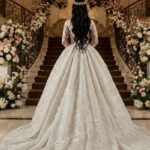The 1960s was a transformative decade in more ways than one, but nowhere was its influence more apparent than in fashion. The vibrant and ever-changing styles of the 1960s continue to inspire the fashion world today. From the rise of the mini skirt to the bold prints and colors that defined a generation, 1960s fashion was all about breaking the mold and embracing individuality.
The Dawn of a Fashion Revolution
Fashion in the 1960s wasn’t just about clothes; it was a statement. As the world witnessed major social, political, and cultural upheavals, fashion evolved to reflect the changes. Youth culture took center stage, and designers no longer adhered to the traditional and modest styles of the previous decade. The mantra of the 1960s became all about freedom of expression and self-confidence.
But what exactly made 1960s fashion so iconic? From mod to bohemian, each style had a distinct character, and each represented different facets of the era’s revolutionary spirit. Let’s dive deeper into the standout trends, influential designers, and cultural movements that shaped this unforgettable decade.
Mod Fashion: Clean Lines and Bold Statements
When you think of 1960s fashion, the mod look immediately comes to mind. Originating in London, mod was all about sharp tailoring, minimalism, and a love for modernity. The rise of the mod subculture helped shape what became the ‘youthquake’ of the decade, a term that captured the power and influence of young people in fashion.
Key Elements of Mod Style:
- Mini Skirts: Perhaps the most iconic piece of clothing from the 1960s. Mary Quant, a British designer, is widely credited with popularizing the mini skirt, which became a symbol of female liberation and empowerment.
- Shift Dresses: Straight, simple, and often in bold colors or graphic prints, the shift dress was a staple for mod women. These dresses were designed to allow freedom of movement, breaking away from the constricting silhouettes of previous eras.
- Go-Go Boots: Sleek, knee-high white boots became a fashion must-have. Paired with mini skirts or dresses, these boots added a futuristic flair to mod outfits.
- Clean, Geometric Prints: Think polka dots, stripes, and color blocks in bright, contrasting colors.
Mod fashion embraced simplicity but wasn’t afraid to be bold. With its clean lines and sharp tailoring, it was a far cry from the romantic, feminine looks of the 1950s. Instead, it was all about empowerment, practicality, and fun.
Bohemian Influence: The Hippie Movement and Free-Spirited Fashion
By the mid-1960s, fashion took a turn towards the eclectic and the relaxed, influenced heavily by the counterculture movement and the rise of bohemianism. The hippie movement was not just a rebellion against societal norms but also against the polished mod aesthetic. This new wave of fashion focused on individuality, creativity, and a deep connection to nature.
Key Elements of Bohemian Fashion:
- Maxi Dresses: Flowing, floor-length dresses became a staple, often adorned with floral prints, earthy tones, and handmade embellishments.
- Tie-Dye and Psychedelic Prints: These colorful, often hand-dyed patterns were a favorite among the youth, reflecting the era’s embrace of freedom and the psychedelic culture of the time.
- Fringes and Suede: Fringed jackets and suede vests became popular, embodying the bohemian desire for simplicity and connection to natural materials.
- Headbands and Flowers: Accessories were also crucial to this look. Headbands, flower crowns, and beaded necklaces completed the free-spirited hippie look.
The bohemian fashion movement celebrated nature, peace, and love, perfectly encapsulating the hippie ethos. Flowing fabrics, ethnic-inspired patterns, and a general sense of looseness were key to this look, a stark contrast to the form-fitting, structured silhouettes of earlier years.
Influential Designers of the 1960s
No discussion of 1960s fashion would be complete without highlighting the designers who pushed boundaries and made waves. Several designers became household names during this decade, leaving lasting legacies in the world of fashion.
- Mary Quant: Known for popularizing the mini skirt, Mary Quant was a trailblazer in 1960s fashion. Her playful, youth-oriented designs helped define the decade.
- André Courrèges: A French designer, Courrèges was known for his futuristic designs, incorporating sleek lines and space-age materials. He is often credited with popularizing go-go boots and the modern mini skirt.
- Pierre Cardin: Cardin’s avant-garde designs played with geometric shapes and bold structures, pushing the boundaries of traditional fashion.
- Yves Saint Laurent: With his revolutionary Mondrian dress and Le Smoking tuxedo suit for women, Yves Saint Laurent challenged the norms of gender and elegance, making him one of the most influential designers of the era.
The Rise of Ready-to-Wear Fashion
The 1960s also marked a shift in the fashion industry with the rise of ready-to-wear (prêt-à-porter) clothing. Before this, high fashion was largely limited to custom, made-to-measure designs from couturiers. However, the democratization of fashion in the 1960s made stylish, affordable clothing available to the masses. Boutiques sprung up everywhere, offering the latest trends without the hefty price tag, further fueling the youthquake.
1960s Fashion Icons: Setting the Trends
The era wasn’t just defined by designers; it was also shaped by the fashion icons who made 1960s fashion look effortlessly cool.
- Twiggy: As one of the first international supermodels, Twiggy embodied the mod aesthetic. Her boyish figure, pixie haircut, and wide-eyed look became the blueprint for many young women during the decade.
- Audrey Hepburn: While she was an icon in the 1950s, Hepburn’s influence carried over into the 1960s, particularly with her chic and timeless style in films like Breakfast at Tiffany’s.
- Jackie Kennedy: As First Lady of the United States, Jackie Kennedy became a fashion symbol with her tailored suits, pillbox hats, and elegant simplicity.
- The Beatles: Not only did The Beatles revolutionize music, but their ever-evolving style also influenced men’s fashion during the decade, particularly their early mod suits and later bohemian-inspired looks.
FAQs About 1960s Fashion
Q: What defined 1960s fashion?
A: 1960s fashion was defined by its bold experimentation, ranging from mod looks with sharp lines and bright colors to free-spirited, flowing bohemian styles. It was a decade of self-expression and breaking away from traditional norms.
Q: Why was the mini skirt so iconic in the 1960s?
A: The mini skirt symbolized women’s liberation and the shifting societal views of the time. It represented youth, freedom, and a rejection of the conservative dress codes of the previous decade.
Q: Who were the key fashion designers of the 1960s?
A: Mary Quant, André Courrèges, Pierre Cardin, and Yves Saint Laurent were some of the most influential designers of the decade, each bringing unique contributions to the fashion world.
Conclusion: The Enduring Legacy of 1960s Fashion
The 1960s was a decade of bold fashion choices and cultural shifts that still resonate today. Whether it’s the lasting influence of mod fashion or the free-spirited nature of bohemian style, the era’s fashion continues to inspire designers and trendsetters alike. It was a time when fashion became more than just clothes—it became a powerful means of expressing individuality, creativity, and rebellion.
For those looking to revisit the iconic looks of this transformative decade, you don’t have to look far. The vibrant spirit of 1960s fashion is alive and well, offering timeless inspiration for today’s wardrobe.
Authoritative Links:
- www.historyoffashion.com/1960s-fashion
- www.fashionhistory.org/60s-trends
- www.influentialdesigners1960s.com





